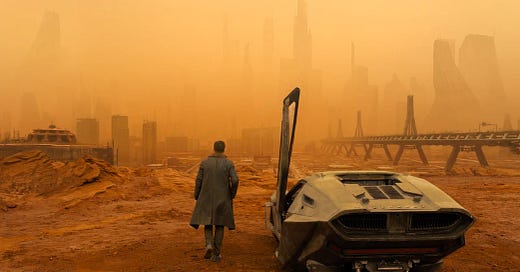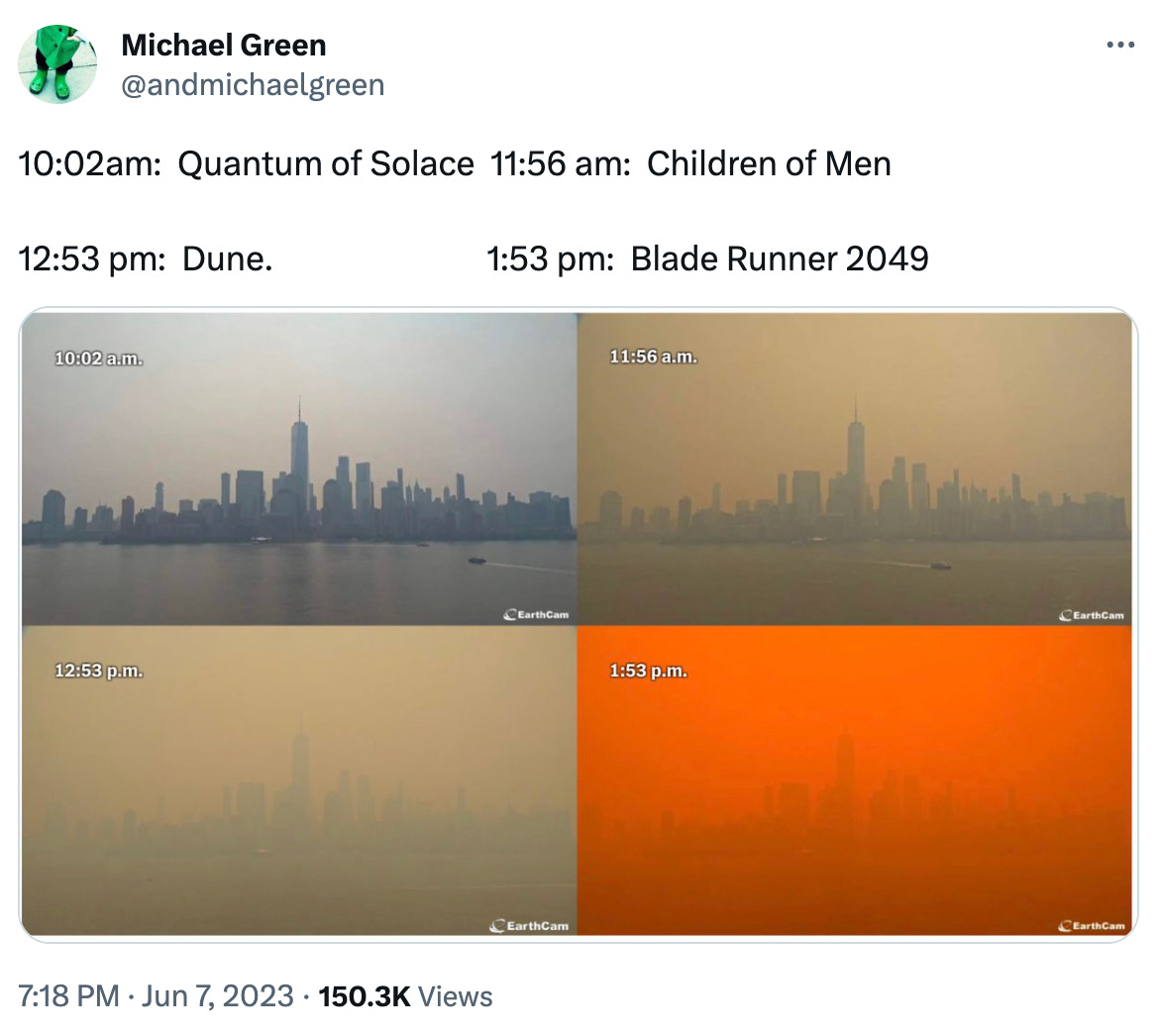Weekend Roundup: Climate Change
This week's dystopian orange skies are a reminder of the dangers ahead
The photo above depicts a dystopian future Las Vegas in the movie Blade Runner 2049, but the disturbing orange haze was eerily similar to scenes from the wildfire smoke that blanketed much of the northeast US this past week. People on social media had a lot of fun with the comparisons to various sci-fi and cyberpunk movies, like this tweet below:
Climate change can sometimes feel abstract and impersonal, but the smoke this week was a visceral reminder that climate change is an omnipresent threat that will change our lives in countless ways over the coming decades. In this Weekend Roundup, I share some relevant climate change stories on both the challenges we face and some areas for optimism.
Improving ventilation is important to fight both respiratory illness, smoke, and other air pollutants
This Op-Ed in the New York Times by an engineering professor at Virginia Tech argues that renovating indoor air systems is a necessary tool to combat both the spread of infectious diseases and climate change health impacts. It’s a compelling read:
“But air quality is a problem big enough that we cannot leave it to individual actions. Air pollution, including wildfire smoke, causes symptoms like coughing, burning eyes, headaches and difficulty breathing in the short term. Long-term exposure to air pollution is associated with increased risk of cardiovascular disease, cancer, worsened asthma symptoms and other chronic diseases. Furthermore, poor air quality is linked to increased absences from school and work and worse academic performance and cognitive function. There is so much to gain by providing everyone with clean air.
People started paying more attention to indoor air quality during the pandemic because we learned that the risk of transmission was higher in poorly ventilated buildings. Popular media described the use of ventilation and filtration to remove the coronavirus from the air. The White House held the Summit on Improving Indoor Air Quality, and the Environmental Protection Agency issued the Clean Air in Buildings Challenge. Improvements in ventilation and filtration should happen in schools and other buildings, and the federal government provided billions of dollars that could have been used to do so. However, much of this remains unspent or was slow to be used, possibly because of a combination of lack of appreciation for the benefits it could bring and lack of guidance on how to obtain and spend the funds.
As we emerge from a pandemic caused by an airborne virus to skies darkened by wildfires, we cannot return to ignorance and complacency about our air. Through a combination of greater public awareness, more widespread implementation of filtration and other air-cleaning technologies and government guidance, we can move into a new era of cleaner air.”
The effects of climate change will be primarily felt by those who did not create the problem
One of the terrible ironies of climate change is that the industrially advanced and wealthy countries that generated the vast majority of CO2 emissions are far less susceptible to the negative effects of a warming planet based geography and ability to adapt than developing countries in Africa, Asia, and Latin America. This inter-country phenomenon is increasingly being seen within countries, as the richest citizens with larger per capita carbon footprints are able to congregate in safer areas and pay to mitigate and repair damage, while poorer citizens remain vulnerable and ignored by the government.
Of course, as we have seen with the wildfires and covid pandemic, problems that start in one region are not always confined there. As temperatures rise, people may migrate to different countries, altering cultures and creating conflicts. Pathogens adapt, and places previously free of “tropical diseases” may soon have to grapple with yellow fever, Dengue, expanding ranges for fungal and rickettsial diseases, and even conceivably malaria. These are a few of the many reasons climate change impacts all of us, and requires global actions.
The economist Adam Tooze has a great deep dive on the “triple inequality” of climate change this week. Read his analysis here:
Insurers may stop writing policies in places that are disproportionately impacted by weather disasters
Natural disasters, particularly hurricanes, are a constant threat in Florida, where I live. Last year, we dodged a bullet when Hurricane Ian made a last minute turn away from a direct hit on the Tampa Bay area and instead destroyed much of the Fort Myers-Naples area. The infographics below show what areas were most impacted by flooding and the heights of storm surge in the epicenter.
Hurricane Ian was estimated to cost over $100 billion in property damage, with insurance payouts covering about half that amount. While not a record (that belongs to hurricane-ridden year 2017), it was well-above average for recent history. Despite the high damage costs, insurers paid out far less than previous years as some underwriters pared back coverage.

Annual insured losses of $100 billion appear to be "the new normal" — Chief climate scientist, Munich Re
As a result, many companies are beginning to stop issuing new homeowner insurance policies in areas most prone to natural disasters like wildfires and flooding, which are amplified by warming temperatures. State Farm recently made headlines for no longer writing home insurance policies in California. All State made a similar change last year. And this is on top of similar shifts in insurance in Florida and Louisiana.
It’s possible that one of the main drivers of climate adaptation in the developed world will be driven by assessing the cold, hard facts of risk of weather damages and ability (or inability) to obtain and pay for insurance.
There are some glimmers of hope in reducing carbon emissions!
Let’s be honest: Talking about climate change can be difficult. It’s a bit depressing and can feel like such a big problem that individuals are powerless to do much. But it’s important to guard against such pessimism that everyone gives up and it becomes a self-fulfilling prophecy. I’m a techno-optimist and think we will find a number of ways to adapt to and mitigate against climate change, although we will certainly not prevent all of the coming disaster.
Believe it or not, there are some pieces of climate progress! We are finally getting to international agreement on the scope of the problem and necessary actions. Climate denialism—while still present—is on the decline. Young people are more likely to express concern about climate change and demonstrate pro-environmental behavior than older generations. The Inflation Reduction Act represents the largest climate bill ever passed in the US and provides hundreds of billions of dollars in incentives for green energy, more energy-efficient buildings, and electric vehicle credits (see below for more on that).
Many countries have already seen their carbon dioxide emission levels peak and fall, although China and India remain outliers. Likewise, economic growth may become uncoupled from fossil fuels.

One specific area where we are racing ahead for climate progress is adoption of electric vehicles (EVs), both in the US and globally. The economist Noah Smith has a great piece on why EV adoption is ramping up so quickly, how beneficial they are for the environment, and punches holes in the arguments of many naysayers. Read more here:
American War
I will close out this Roundup with a novel recommendation. Omar El Akkad is an Egyptian-borne journalist and writer who left the middle east in his teens to pursue an education in Canada, and he currently lives in the Pacific Northwest. His debut novel American War paints a frighteningly plausible picture of a future United States fractured by a Second Civil War, which was in turn sparked by climate change and pandemic disease (sound familiar?) The book is littered with casual references to how different the world is a century from now, from the newly-created Category Six hurricane to events that occur on an island in the Florida Sea (the peninsula has been completely submerged by the 2080s). There are also many scenes inspired by his first person coverage of the Arab Spring and war in Afghanistan. The high-concept sci-fi setting drew me in, but what kept me reading was the humanity of the characters. Ultimately, the novel tries to answer deeply human questions: How far will you go to survive and protect your family? What makes makes a normal citizen rise up and fight against their country?










